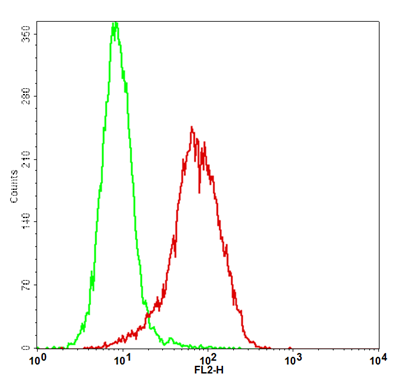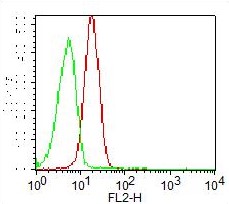Monoclonal Antibody to mouse CD34(Discontinued)

Figure-1: CD34 in mouse glioma. Staining of paraffin tissue section with antibody MEC14.7. Antimouse CD34 at 5 µg/ml resulted in the specific staining of endothelial cells.
Roll over image to zoom in
Shipping Info:
For estimated delivery dates, please contact us at [email protected]
| Amount : | 500 µg |
| Isotype : | Rat IgG2a |
| Content : | 0.5 mg, 0.2 µm filtered antibody solution in PBS, containing 0.1% bovine serum albumin and 0.02% sodium azide. |
| Storage condition : | Product should be stored at 4 °C. Under recommended storage conditions, product is stable for one year. |
The monoclonal antibody MEC14.7 recognizes mouse CD34, a single-pass type I membrane glycophosphoprotein present on small vessel endothelial cells and hematopoietic progenitor cells. The apparent molecular mass of CD34 is heterogeneous, depending on the glycosylation state in different cell types. In cultured endothelioma cell lysate, CD34 has a molecular weight of ~100 kDa, whereas in lung lysates it is ~80 kDa. 2 Isoforms of CD34 exist, both are expressed on the cell surface.CD34 is an adhesion molecule performing a role in early hematopoiesis by mediating the attachment of stem cells to the bone marrow extracellular matrix or directly to stromal cells. CD34 acts as a scaffold for the attachment of lineage specific glycans, allowing stem cells to bind to lectins expressed by stromal cells or other marrow components. CD34 presents carbohydrate ligands to selectins.CD34 is widely used as a marker to select early hematopoietic stem and progenitor cells in experimental and clinical hematopoiesis. The monoclonal antibody MEC14.7 recognizes a neuraminidase sensitive epitope on endothelium in vivo, particularly on small vessels and neoformed capillaries and developing vascular structures in embryonal structures. The monoclonal antibody MEC14.7 can be used for identification and characterization of capillary endothelial cells. Furthermore, the antibody is useful for isolation and characterization of hematopoietic progenitor cells, particularly of myelomonocytic colony forming cells. Monoclonal antibody MEC14.7 is also useful for immunopurification and cell separation
Western Blot Analysis: both reduced/non-reduced; 70-105 kDa, depending on glycosylation state and cell type IHC-P: Formalin fixed; boiled twice for 5 minutes in citrate (pH 6.0) as antigen retrieval or 0.03 % trypsin treatment for 10 minutes at 37 °C FACS Analysis: mice blood cells; 0.1 µg MEC14.7/106 cells Immuno Precipitation: ~100 kDa protein in H5V cells CD34 in mouse glioma. Staining of paraffin tissue section with antibody MEC14.7 . Anti-mouse CD34 at 5 µg/ml (o/n, 4 °C) resulted in the specific staining of endothelial cells. For immunohistology, flow cytometry and Western blotting, dilutions to be used depend on detection system applied. It is recommended that users test the reagent and determine their own optimal dilutions. The typical starting working dilution is 1:50. For functional studies, in vitro dilutions have to be optimized in user's experimental setting.
For Research Use Only. Not for use in diagnostic/therapeutics procedures.
| Subcellular location: | Membrane |
| Post transnational modification: | Phosphorylated on serine residues by PKC. |
| Tissue Specificity: | Highly expressed in hematopoietic progenitor cell lines, brain and testis, and moderately in the thymus, spleen, and bone marrow, but not in adult liver. |
|
There are currently no product reviews
|

















.png)












